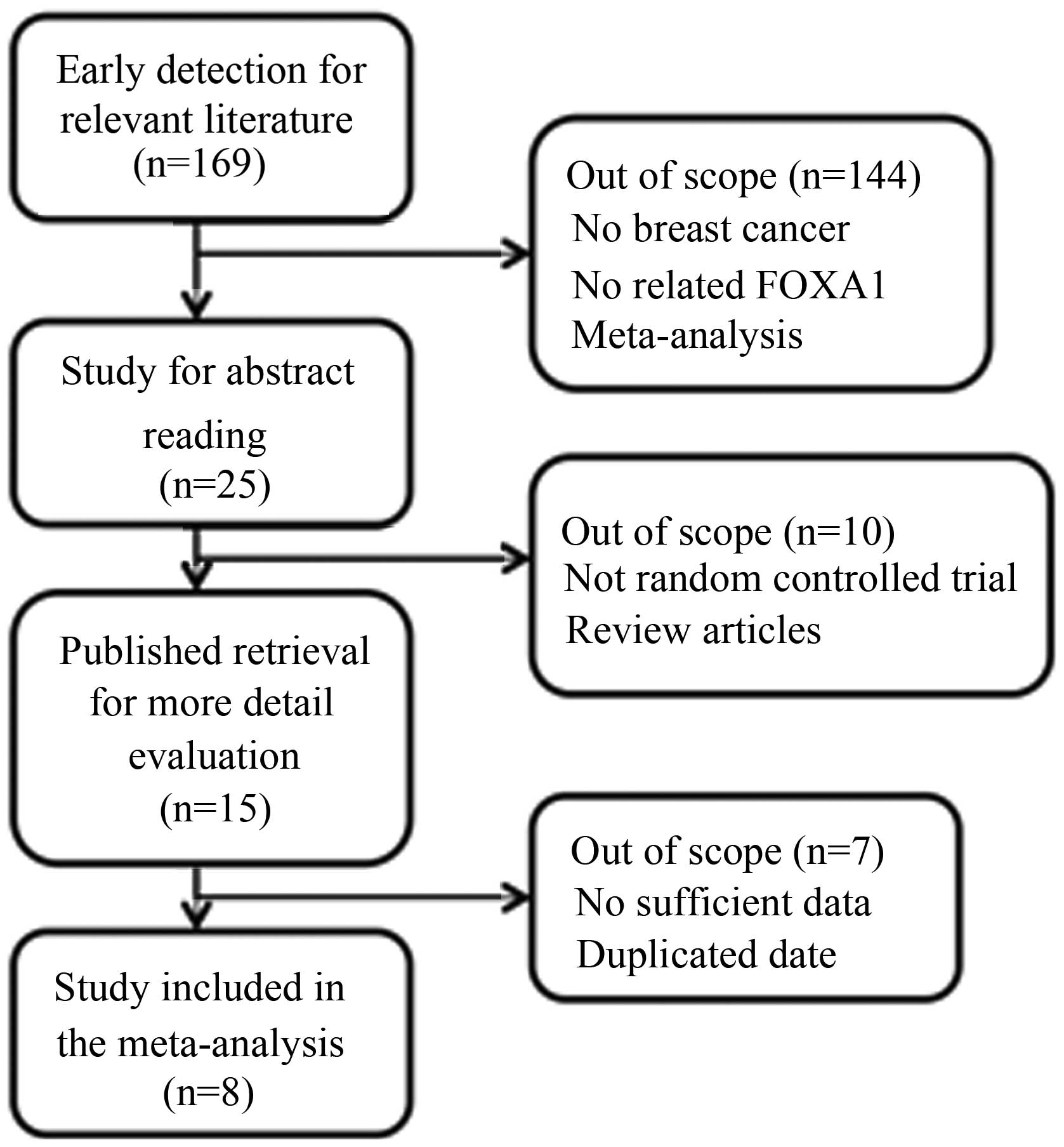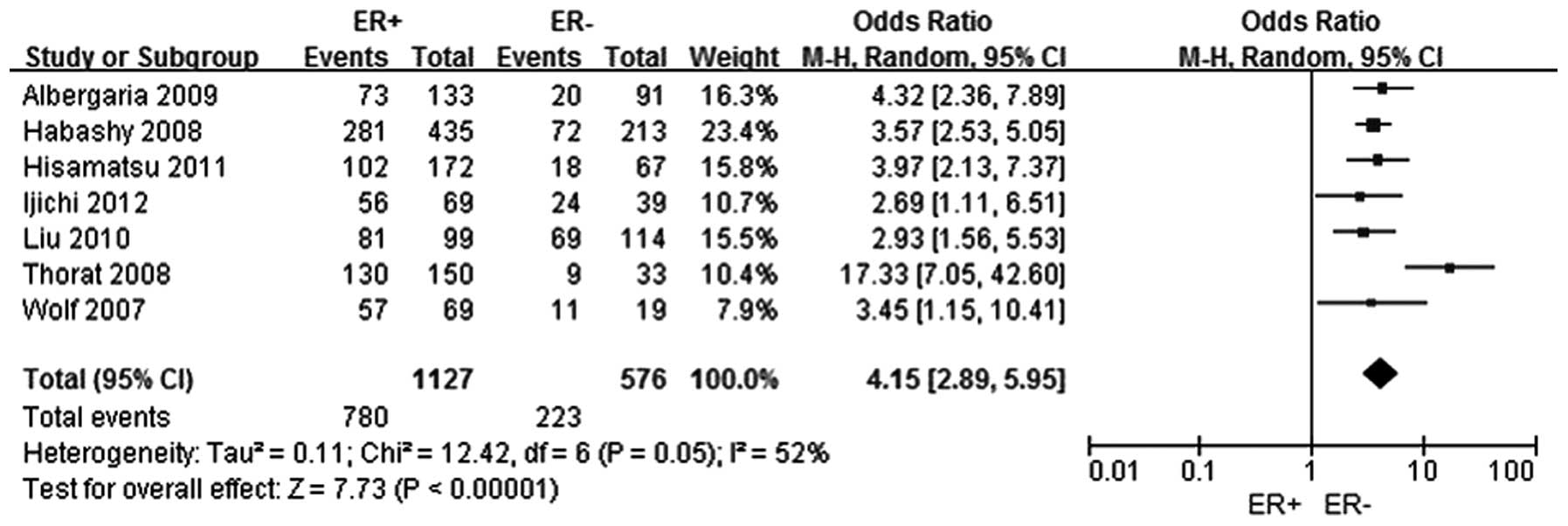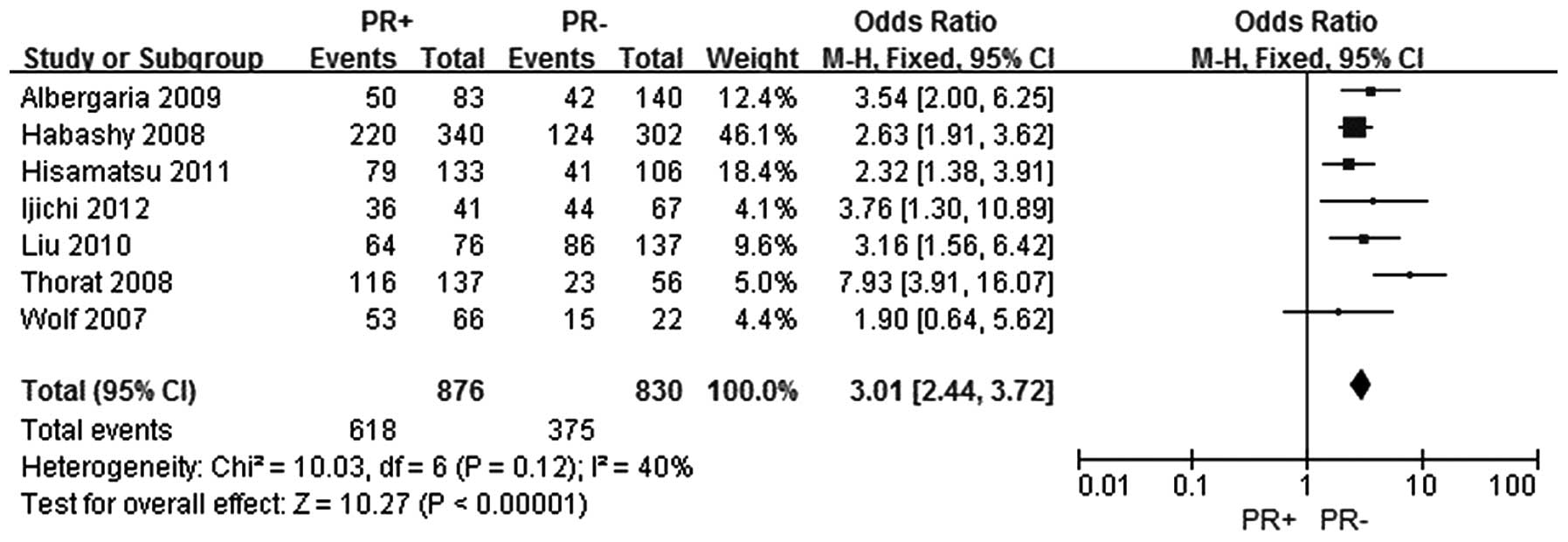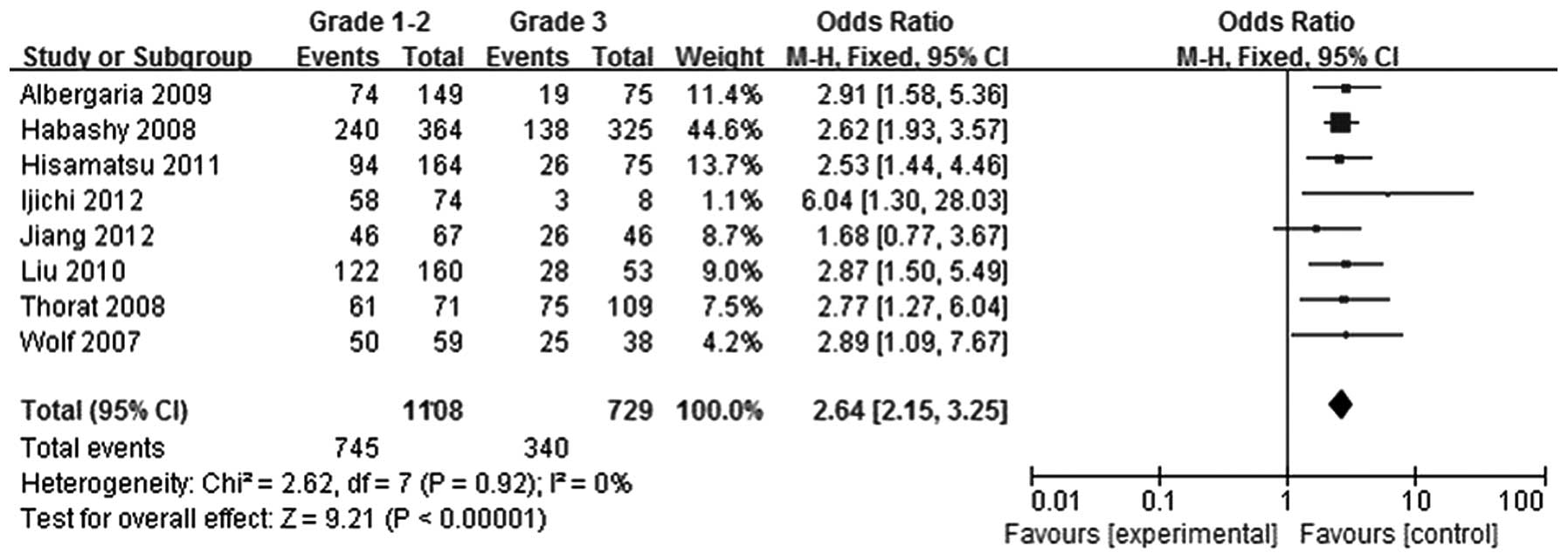|
1
|
Forouzanfar MH, Foreman KJ, Delossantos
AM, Lozano R, Lopez AD, Murray CJ and Naghavi M: Breast and
cervical cancer in 187 countries between 1980 and 2010: A
systematic analysis. Lancet. 378:1461–1484. 2011. View Article : Google Scholar : PubMed/NCBI
|
|
2
|
Clark GM: Prognostic and predictive
factors for breast cancer. Breast Cancer. 2:79–89. 1995. View Article : Google Scholar : PubMed/NCBI
|
|
3
|
Bernardo GM and Keri RA: FOXA1: A
transcription factor with parallel functions in development and
cancer. Biosci Rep. 32:113–130. 2012. View Article : Google Scholar : PubMed/NCBI
|
|
4
|
Nakshatri H and Badve S: FOXA1 in breast
cancer. Expert Rev Mol Med. 11:e82009. View Article : Google Scholar : PubMed/NCBI
|
|
5
|
Hisamatsu Y, Tokunaga E, Yamashita N, et
al: Impact of FOXA1 expression on the prognosis of patients with
hormone receptor-positive breast cancer. Ann Surg Oncol.
19:1145–1152. 2012. View Article : Google Scholar : PubMed/NCBI
|
|
6
|
Wolf I, Bose S, Williamson EA, Miller CW,
Karlan BY and Koeffler HP: FOXA1: Growth inhibitor and a favorable
prognostic factor in human breast cancer. Int J Cancer.
120:1013–1022. 2007. View Article : Google Scholar : PubMed/NCBI
|
|
7
|
Habashy HO, Powe DG, Rakha EA, et al:
Forkhead-box A1 expression in breast cancer and its prognostic
significance. Eur J Cancer. 44:1541–1551. 2008. View Article : Google Scholar : PubMed/NCBI
|
|
8
|
Thorat MA, Marchio C, Morimiya A, Savage
K, Nakshatri H, Reis-Filho JS and Badve S: Forkhead box A1
expression in breast cancer is associated with luminal subtype and
good prognosis. J Clin Pathol. 61:327–332. 2008. View Article : Google Scholar : PubMed/NCBI
|
|
9
|
Albergaria A, Paredes J, Sousa B, et al:
Expression of FOXA1 and GATA-3 in breast cancer: The prognostic
significance in hormone receptor-negative tumours. Breast Cancer
Res. 11:R402009. View
Article : Google Scholar : PubMed/NCBI
|
|
10
|
Liu N, Niu Y, Wang SL, Yu Q, Zhang RJ and
Liu TJ: Diagnostic and prognostic significance of FOXAl expression
in molecular subtypes of breast invasive ductal carcinomas.
Zhonghua Yi Xue Za Zhi. 90:1403–1407. 2010.(In Chinese). PubMed/NCBI
|
|
11
|
Ijichi N, Shigekawa T, Ikeda K, et al:
Association of double-positive FOXA1 and FOXP1 immunoreactivities
with favorable prognosis of tamoxifen-treated breast cancer
patients. Horm Cancer. 3:147–159. 2012. View Article : Google Scholar : PubMed/NCBI
|
|
12
|
Jiang GY, Li H, He WL and Wang NX:
Prognostic significance of FOXA1 and BRCA1 expression in triple
negative breast cancer. Zhongguo Bing Li Sheng Li Za Zhi.
28:1230–1234. 2012.(In Chinese).
|
|
13
|
Higgins JP and Thompson SG: Quantifying
heterogeneity in a meta-analysis. Stat Med. 21:1539–1558. 2002.
View Article : Google Scholar : PubMed/NCBI
|
|
14
|
DerSimonian R and Kacker R: Random-effects
model for meta-analysis of clinical trials: an update. Contemp Clin
Trials. 28:105–114. 2007. View Article : Google Scholar : PubMed/NCBI
|
|
15
|
Ademuyiwa FO, Thorat MA, Jain RK,
Nakshatri H and Badve S: Expression of Forkhead-box protein A1, a
marker of luminal A type breast cancer, parallels low oncotype DX
21-gene recurrence scores. Mod Pathol. 23:270–275. 2010. View Article : Google Scholar : PubMed/NCBI
|
|
16
|
Kawase M, Toyama T, Takahashi S, et al:
FOXA1 expression after neoadjuvant chemotherapy is a prognostic
marker in estrogen receptor-positive breast cancer. Breast Cancer.
Jun 16–2013.(Epub ahead of print). PubMed/NCBI
|
|
17
|
Imamura Y, Sakamoto S, Endo T, et al:
FOXA1 promotes tumor progression in prostate cancer via the
insulin-like growth factor binding protein 3 pathway. PloS One.
7:e424562012. View Article : Google Scholar : PubMed/NCBI
|
|
18
|
Badve S, Turbin D, Thorat MA, et al: FOXA1
expression in breast cancer-correlation with luminal subtype A and
survival. Clin Cancer Res. 13:4415–4421. 2007. View Article : Google Scholar : PubMed/NCBI
|
|
19
|
McCune K, Mehta R, Thorat MA, Badve S and
Nakshatri H: Loss of ERα and FOXA1 expression in a progression
model of luminal type breast cancer: Insights from PyMT transgenic
mouse model. Oncol Rep. 24:1233–1239. 2010.PubMed/NCBI
|
|
20
|
Bernardo GM, Lozada KL, Miedler JD, et al:
FOXA1 is an essential determinant of ERα expression and mammary
ductal morphogenesis. Development. 137:2045–2054. 2010. View Article : Google Scholar : PubMed/NCBI
|
|
21
|
Hisamatsu Y, Tokunaga E, Yamashita N,
Akiyoshi S, Okada S, Nakashima Y, et al: Impact of GATA-3 and FOXA1
expression in patients with hormone
receptor-positive/HER-2-negative breast cancer. Breast Cancer. Jan
11–2014.(Epub ahead of print). PubMed/NCBI
|
|
22
|
Hosoda M, Yamamoto M, Nakano K, et al:
Differential expression of progesterone receptor, FOXA1, GATA3, and
p53 between pre- and postmenopausal women with estrogen
receptor-positive breast cancer. Breast Cancer Res Treat.
144:249–261. 2014. View Article : Google Scholar : PubMed/NCBI
|
|
23
|
Lin L, Miller CT, Contreras JI, et al: The
hepatocyte nuclear factor 3 α gene, HNF3α (FOXA1), on chromosome
band 14q13 is amplified and overexpressed in esophageal and lung
adenocarcinomas. Cancer Res. 62:5273–5279. 2002.PubMed/NCBI
|
|
24
|
Nucera C, Eeckhoute J, Finn S, et al:
FOXA1 is a potential oncogene in anaplastic thyroid carcinoma. Clin
Cancer Res. 15:3680–3689. 2009. View Article : Google Scholar : PubMed/NCBI
|
|
25
|
Barbieri CE, Baca SC, Lawrence MS, et al:
Exome sequencing identifies recurrent SPOP, FOXA1 and MED12
mutations in prostate cancer. Nat Genet. 44:685–689. 2012.
View Article : Google Scholar : PubMed/NCBI
|
|
26
|
Abe Y, Ijichi N, Ikeda K, Kayano H,
Horie-Inoue K, Takeda S and Inoue S: Forkhead box transcription
factor, forkhead box A1, shows negative association with lymph node
status in endometrial cancer, and represses cell proliferation and
migration of endometrial cancer cells. Cancer Sci. 103:806–812.
2012. View Article : Google Scholar : PubMed/NCBI
|
|
27
|
Sérandour AA, Avner S, Percevault F, et
al: Epigenetic switch involved in activation of pioneer factor
FOXA1-dependent enhancers. Genome Res. 21:555–565. 2011. View Article : Google Scholar : PubMed/NCBI
|
|
28
|
Hu Q, Luo Z, Xu T, et al: FOXA1: A
promising prognostic marker in breast cancer. Asian Pac J Cancer
Prev. 15:11–16. 2014. View Article : Google Scholar : PubMed/NCBI
|
|
29
|
Beck S, Sommer P, dos Santos Silva E, Blin
N and Gött P: Hepatocyte nuclear factor 3 (winged helix domain)
activates trefoil factor gene TFF1 through a binding motif adjacent
to the TATAA box. DNA Cell Biol. 18:157–164. 1999. View Article : Google Scholar : PubMed/NCBI
|
|
30
|
Williamson EA, Wolf I, OKelly J, Bose S,
Tanosaki S and Koeffler HP: BRCA1 and FOXA1 proteins coregulate the
expression of the cell cycle-dependent kinase inhibitor p27 (Kip1).
Oncogene. 25:1391–1399. 2006. View Article : Google Scholar : PubMed/NCBI
|
|
31
|
Liu YN, Lee WW, Wang CY, Chao TH, Chen Y
and Chen JH: Regulatory mechanisms controlling human E-cadherin
gene expression. Oncogene. 24:8277–8290. 2005. View Article : Google Scholar : PubMed/NCBI
|
|
32
|
Mehta RJ, Jain RK, Leung S, Choo J,
Nielsen T, Huntsman D, Nakshatri H and Badve S: FOXA1 is an
independent prognostic marker for ER-positive breast cancer. Breast
Cancer Res Treat. 131:881–90. 2012. View Article : Google Scholar : PubMed/NCBI
|
|
33
|
Nakshatri H and Badve S: FOXA1 as a
therapeutic target for breast cancer. Expert Opin Ther Targets.
11:507–14. 2007. View Article : Google Scholar : PubMed/NCBI
|
















